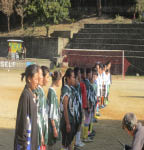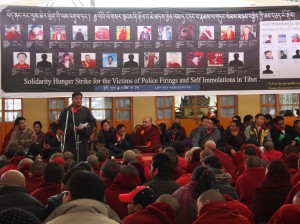 While most Tibetan Children’s Village students enjoyed an increased measure of relaxation and freedom this winter holiday, a group of Tibetan girls with lofty goals came together in nearby Gopalpur for one very intense, structured month… of football.
While most Tibetan Children’s Village students enjoyed an increased measure of relaxation and freedom this winter holiday, a group of Tibetan girls with lofty goals came together in nearby Gopalpur for one very intense, structured month… of football.
Cassie Childers, working in conjunction with the Tibetan National Sports Association, organized the program for twenty-eight Tibetan girls aged eleven to twenty. The team would spend one month in residence at TCV Gopalpur undergoing physical, mental and leadership training. Three girls were selected from each TCV school across India, based on their aptitude for the sport of football and their enthusiasm to become ambassadors among their classmates. Each girl is expected to take her newfound knowledge back to her respective school and help inspire other girls to take part in the nascent program.
Some of the girls’ most important experiences had less to do with skill than with accepting and embracing a level of physicality to which they were completely unaccustomed. “It’s important to note that on the day they showed up, only four of them had played before. There were tears when they got hit with the ball,” Childers said. “Change didn’t come the next day, but by the morning of the last match, players with bloody noses were begging to go back into the action. They were calling their own ‘offsides.’ These girls learned the game and they love it.”
In order to have a well-rounded and lasting impact, Childers and her assistants which included a professional football player from Europe, a sports psychologist from Delhi and a goalkeeping expert from the United States focused on more than just the tactics needed on the pitch. Each morning, Childers led the girls on a short run to improve aerobic fitness or a yoga session to increase balance and flexibility. Their midday activities included everything from lessons on gender equality to team-building exercises to writing letters to the team’s American sponsors.
This sort of immersion experience aimed to make the girls understand that they can be part of something much larger than just a month-long introduction to football. Childers continues to line up funding to support the growth and expansion of Tibet Women’s Football, with the goal of one day competing internationally. Mr. Kalsang Dhondup, General Secretary of the TNSA, has been intricately involved in the early stages, promising his organization’s long-term commitment to empowering women through sport and seeing the program through to maturity. The girls, too, all show a strong resolve that, one day, female athletes will represent Tibet to the rest of the world.
Childers, wanting the girls to accept nothing less than their biggest dreams, played recordings of a few big matches from last summer’s FIFA Women’s World Cup. On one of the last nights, fighting fatigue after a grueling afternoon training session, the girls watched wide-eyed as Japan’s women, with hearts of champions, won against the heavily-favored United States team. The commentators couldn’t help but remark that their passionate play and eventual victory in the World Cup Final would help heal a wounded nation, fresh from the devastation of the March 2011 earthquake and tsunami.
The message was not lost on the Tibetan girls, who know their nation also faces a long road to healing. However daunting the situation in Tibet may become, the girls now glow with excitement at the opportunity to contribute in a positive way through football. “For most people who have found something to love, you can trace it to a seminal experience,” said Carey Russell, who spent ten days filming the girls for a documentary series on the Tibetan exile experience sponsored by the International Center for Mental Health and Human Rights (www.icmhhr.org). “To say this month will serve as a spark in these young women’s lives is an understatement.”
Nij Herbert, a volunteer from London, England, helped train the girls in defensive tactics and coached one of the teams during the girls’ final exhibition match. To him, the girls’ growth in just one month was astounding. “At first, they weren’t playing tough. It was a little bit halfhearted. What I wanted was for them to tackle hard and really want the ball. I think all the Barcelona stuff comes after,” he said. As the group gelled and absorbed their training, though, everything changed. “We saw this real hunger and enthusiasm. The next step is beautiful football, but for now, they’ve learned tough football. They worked so hard and made us proud.”
Childers added, “The girls suddenly realized, ‘if I want the ball, I have to push.’ So they did.”
The girls’ sore muscles will receive a well-deserved rest during the second half of February. As they head back to school, some to the far reaches of Ladakh and Karnataka, they’ll be more than students. They will also have to make the transition to being leaders among their peers to be the seeds of a big dream and a growing program and the push to make Tibet Women’s Football a reality




 Print
Print Email
Email